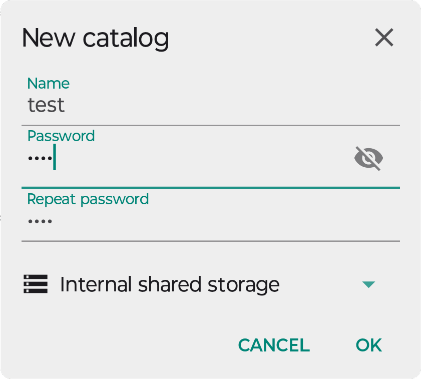The Vault is a way to store your sensitive files securely in an encrypted place. The place is a folder on your device’s storage, specifically it’s folder named .X-plore vault on available storage, typically it is Internal storage.
X-plore creates a special entry named Vault in top-level list of available locations, and all your encrypted files will be accessible from there.
Vault catalogs
You can create one or more catalogs containing encrypted files inside. Each such catalog may contain hierarchy of folders and files, and one catalog uses same password to encrypt all files inside.
The real format of the catalog is actually encrypted Zip file using AES-256 encryption. So this allows you to send entire such catalog to someone or somewhere, and it will still be readable by other tools available on computers where Zip file can be opened. The shared Zip will be readable only with password used to create it.
Technical note: because Zip format doesn’t allow to encrypt filenames, and we consider filenames to be also sensitive information, a trick is used how data in the Zip file are stored. The encrypted Zip file (the catalog) contains yet another Zip file inside, which is encrypted using your password including all filenames in it, so that possible prying eyes don’t see anything from encrypted files inside. X-plore’s Vault hides this extra Zip file inside, but if you open the file in another Zip extractor, you’ll see single file named data.zip which, after entering correct password, will reveal your files.
Why this way? Because we want your Vault files to be exportable in common format and openable elsewhere. And we want it to be proper Vault, including hidden filenames. Why not using RAR or 7Zip format which allows native filename encryption? Because creating RAR is a licensed technology, and 7Zip is not so widely used. So ZipInZip was winning solution.
Creating catalog
To create new Vault catalog, open the Vault entry in X-plore, click on Options item and choose New. Then you’ll need to enter file name of the catalog and password with which files inside will be encrypted.
In case that your device has external storage such as SD card or USB stick, the create dialog will allow you to choose storage where the catalog will be created.

Using catalog
Once the catalog is created, you can open it as normal folder, and create folders or copy files in or out. Actually it works same as encrypted Zip files.
You can also copy entire catalog to other place, or share it using some compatible application (for example send by email). In such case, the catalog will become encrypted Zip, and it can later be opened on another computer, assuming that the user knows the password.
You can also delete the catalog when you don’t need it, rename or duplicate it.
Changing password
You can change password on existing catalog. Long-click on catalog and choose Change password. You’ll need to enter old password, new password, and repeat new password again. After confirming, catalog will be encrypted with new password (which may take some time depending on its size).
Forgotten password
If you forget the vault password, you’re locked out of your files. The task to find the password and recover your files is as hard as recovering Zip password, you can learn on the Internet if it is at all possible.
Using Fingerprint sensor
On devices with fingerprint sensor, it is possible to save catalog’s password using fingerprint scan. The result is that you don’t need to type password when opening catalog, but simply use finger scan to open encrypted catalog. This brings possibility to use longer passwords, resulting in increased security. Drawback is that it may lead to you forgetting the password if you’ll use only fingerprint scanner for longer time.
ⓘ For this to work, your device must have enrolled fingerprint and set up secure screen lock using fingerprint scanner.
You’ll get the option to save typed password when you open the catalog. During opening catalog and typing password, check the Use fingerprint in future option, and confirm by fingerprint scan. Entered password will be encrypted and saved in a safe place, and next time when you’ll open the catalog, you can use just your fingerprint.
To undo this – removing saved fingerprint, just type password manually and don’t check the Use fingerprint in future option. Saved fingerprint-protected password will be removed.
Note that the saved fingerprint password will be reset when you change catalog password, or when you modify device’s fingerprint setting (such as enroll new finger). So it’s highly recommended to use passwords that you don’t forget, so that you don’t lock yourself out of your encrypted files.
In case that you forget password but still can open catalog using fingerprint, it may be wise to create a new catalog and copy files out of old catalog while you can still open it.
What when you uninstall X-plore
The catalogs are stored in a public place on device’s storage, so they will still be there when you uninstall X-plore. You can later install X-plore again, and it will find the files, or you can use other tool to open these as Zip files.
Paid function
Vault encryption is paid function. Without payment, you can use only one catalog.